
Nowadays every company is affected by CE/EMI demands. The use of electronics increases, as well as the operating frequencies. Therefore, radiation and immunity has to be taken into account in an early stage during the development of new products. In many cases EMI problems cannot be solved at PCB level; the enclosures and cables have to be shielded.
When to employ shielding
Shielding is a fast way to comply with legal demands like CE or FCC or to prevent electromagnetic interference. Since time-consuming development is not required, it is also a cost-effective practice. Shielding is therefore recommended for smaller production quantities or if a quick market introduction is needed. It is also used for appliances with high radiation or sensitivity levels or for products in which these levels are not known in advance, like modular enclosures.
Radiation and conduction
Electromagnetic interference can be transferred by radiation and conduction. Conduction plays an important role with frequencies below 10 MHz; to prevent this, cables and enclosures have to be shielded with magnetically conductive materials. The lower the frequency, the thicker the shielding needs to be. For high frequencies (HF shielding, above 40 MHz), only a very thin layer of highly conductive material is needed.
Avoid gaps
The higher the frequency, the shorter the wavelength. This means that when the frequency increases, the tolerable gap dimensions decrease. In other words doors, panels and other parts need to be connected electrically on all sides. The easiest way to do this is with highly conductive EMI shielding gaskets. Most of them are self-adhesive for easy mounting.
To select the appropriate gasket, several aspects have to be taken into account: the rigidity of the construction, the distance between the fixings and the construction materials used.
The allowed stiffness of the gasket depends on the rigidity of the construction and the distance between the fixings. If the gasket is too stiff, the door, lid or panel will deflect and gaps will be caused instead of prevented (Figure 1). Several kinds of gaskets have been developed especially for doors, which combine a very large compression range, low closure force and high conductivity. Many of them can be used in existing products without changing the construction. The gasket selection diagram in Graph 1 is very helpful to determine the appropriate gasket material.
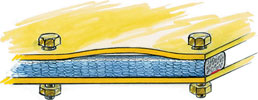
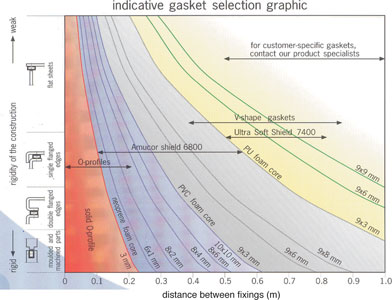
Galvanic corrosion
The conductive layer on the outside of the gasket needs to be in the same galvanic range as the construction materials, otherwise galvanic corrosion will occur and the electrical conduction between the parts will be lost. This will obviously decrease the shielding performance. Commonly used criteria are for no more than 0,3 Volts for harsh environments (salt spray/weathering) and no more than 0,5 Volts for benign environments (indoors, salt-free condensation only). See Table 1 for an overview of the galvanic range.
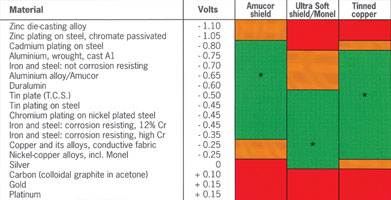
To obtain a contact surface within the same galvanic range as the conductive covering of the gaskets, a metal tape with conductive self-adhesive can be applied. This can be provided with a masking tape of a smaller width. The paint overlaps the tape, which increases bonding and corrosion resistance (Figure 2).
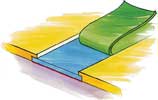
Another way to avoid galvanic corrosion is to take care that the environmental influences do not reach the EMI shielding gasket, for example with a combined EMI/water seal (Figure 3).
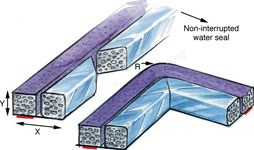
Some manufacturers of EMI shielding gaskets use layers containing carbon on the outside to prevent corrosion of the gasket. Please be aware that these are not galvanically compatible with many commonly used construction materials and that corrosion of the contact surfaces of the construction will take place. EMI shielding gaskets with a conductive layer of reinforced Amucor foil are much more compatible with materials like zinc plated steel and aluminium, and will prevent this kind of corrosion.
Displays/vent panels
Not only connections between construction parts, but of course also displays and vent panels need to be shielded. Displays can be provided with a sputtered transparent conductive coating for HF shielding (above 30 MHz, Figure 4a) or a fine metal wire mesh for lower frequency/high performance shielding (Figure 4b). The conductive sputter layer can be coated directly on the display or can be supplied on thin films for smaller amounts.
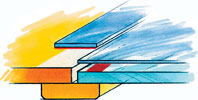
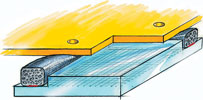
Of course, the shielding of the displays will have to be connected with the shielding of the enclosure to guarantee optimal damping. This can be done with a gasket or metal tape with conductive self-adhesive.
Vent panels are usually shielded with aluminium honeycomb vents. These give excellent shielding performance with minimal loss of airflow. For superb shielding performance so-called cross-cell honeycomb vents are used. These consist of two or more layers of aluminium honeycomb, rotated 90° (Figure 5). Honeycombs are usually applied with a rigid aluminium frame and a gasket of 2–5 mm for optimal connection with the construction.
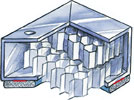
Cables
To prevent radiation from escaping past the shielding through power and signal cables, they need to be shielded or filtered. Shielding can be provided by ready-made shielded cables, shielding tube and cable wrapping. Shielding tube consists of hollow braided metal wire, through which the cable or bundle of cables can be pulled to shield it. Cable wrapping is a knitted metal wire tape, which is wrapped around a cable or bundle of cables. With this, it is very easy to make branches.
The shielding of the cables always needs to be connected properly with the shielding of the enclosure; otherwise the cable will act as an antenna and the shielding will be useless.
For heavy duty and military applications, shielded cable glands and special cable entry systems with compressed conductive rubber seals are commonly used. For commercial applications and appliances that do not need a water seal, Entry-shield is used in most cases. Entry-shield consists of two pre-compressed flexible strips of EMI shielding gasket, between which the cables are entered. This way, many cables can be entered simultaneously with minimal mounting and it is simple to add cables later (Figure 6).
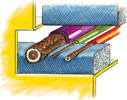
Connectors
What was said about cables also applies for connectors. These also need to be shielded or filtered and connected with a gasket. These gaskets can consist of 1 mm thick die-cut material, which can also be manufactured easily according to customer specifications, with low tooling costs (Figure 7).

Shielding at the source
If the source of the radiation or sensitivity is known, shielding can be applied at the source. The interfering parts can be packed in a folded box or envelope of die-cut shielding foil with an insulating layer on the inside to avoid short-circuiting (Figure 8).
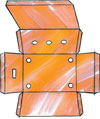
This shielding can also be accomplished by soldering vertical metal strips on the PCB to create compartments. These compartments are closed by adding a lid of flexible die-cut shielding foil (Figure 9) or by pressing a soft foam sheet with a conductive surface against the strips (Figure 10). With the latter option, many compartments can be shielded with just a single cover.
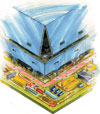
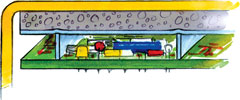
| Tel: | +27 11 726 6758 |
| Email: | [email protected] |
| www: | www.eispty.co.za |
| Articles: | More information and articles about Electronic Industry Supplies |
© Technews Publishing (Pty) Ltd | All Rights Reserved